RED LAKE, ONTARIO — For the management team at newly minted Pure Gold Mining (TSXV: PGM; US-OTC: LRTNF), picking up the past-producing Madsen gold project marked a return to a gold camp that has played a formative role in their geological careers. The project encompasses 50 sq. km in Ontario’s prolific Red Lake greenstone belt, and it’s hard to find a name on the company’s technical roster that doesn’t boast significant experience in the region.
That’s a big reason that Madsen stood out for director Mark O’Dea and president and CEO Darin Labrenz during the search for a project that could serve as a “company builder” for a new vehicle. Labrenz recounts his time as chief geologist with Placer Dome at the Campbell mine complex in Red Lake during a drive out to the Red Lake Regional Heritage Centre, and points out a plethora of headframes owned by Goldcorp (TSX: G; NYSE: GG) to highlight the ongoing importance of the district.
“When the markets turned a bit sour two years ago it became evident that people just were not that interested in more prospective exploration stories, and we knew we needed to bring an advanced-stage asset into the company,” Labrenz continues.
“I had conversations with Mark, and one of the projects that stuck out to us was Madsen. Remember that (O’Dea-led) Fronteer Gold had its origins in the Red Lake camp and we had both done a lot of work in the area. We like the fact it is a high-grade deposit in a Canadian jurisdiction. It really has all those things we were looking for in a project,” he says.
And Madsen is a large part of Red Lake’s heritage. The property hosts two historic mines that cranked out 2.4 million oz. gold between 1935 and 1974, which makes it the second-largest past producer in Red Lake. The district has hosted 28 mines since 1925 and produced 25 million oz. gold, with over 85% from three operations: the Campbell mine, the Dickenson-Red Lake mine and Madsen.
Red Lake’s heritage museum houses artifacts and antiques from a gold rush that dates back to 1926, when over 3,000 people travelled by dogsled and foot over frozen lakes and rivers.
Labrenz points out that despite its more than 80-year history, Red Lake is yielding exciting new deposits, including Goldcorp’s High Grade zone discovery and newly commissioned Cochenour-Bruce Channel operation.
“You can now drive through and see these new headframes, and I think that really reflects the renaissance of discovery in the area. The revival comes from a new understanding of the controls of high-grade mineralization in Red Lake,” Labrenz says during a presentation at the museum. “When we look at Madsen we focus on the fact that this asset hasn’t seen that renaissance.”
The “revival” Labrenz refers to took root during a unique initiative launched by former Goldcorp CEO Rob McEwen in 2000.
While the High Grade zone was discovered in 1995, and drilled extensively in the years leading up to first commercial production from the zone in 2001, the “Goldcorp Challenge” of 2000 brought the mine’s challenging geology into the public sphere in an unprecedented way.
McEwen made all of Goldcorp’s Red Lake data public and offered hundreds of thousands of dollars in cash prizes to outside experts or anyone else who could help the company make its next 6 million oz. gold discovery.
Some good and helpful ideas came out of the contest, and the company gained positive publicity for years to come.
This year Goldcorp’s expansive Red Lake operation is expected to produce between 440,000 and 480,000 oz. gold at all-in sustaining costs of US$900 per oz.
The Goldcorp Challenge’s first-place prize was awarded to Australian Nick Archibald and his geological team at Fractal Graphics, but you only have to look at the list of semi-finalists to see how the story relates to Pure Gold. O’Dea placed second in the competition, while the company’s geological advisor Christopher Lee ranked amongst the top-25 entries.
“Goldcorp’s challenge really brought a lot more attention to the district. Madsen has been stuck in an operational focus for the past seven years, and so what we’re bringing to the project is a real focus on exploration,” Labrenz continues. “Our stated objective is to make the next million-ounce gold discovery in the district. The mill offers a great foundation, but we want to make discoveries because that’s what we think will propel the story forward.”
The drive from Red Lake down to the historic Madsen site circles around Goldcorp’s operations right along the 12 km long unconformity that hosts most of the project’s gold resources.
An old headframe looms over Pure Gold’s site office with “Madsen” written on the side in worn-black paint.
Pure Gold is running exploration efforts out of a 500-tonne-per-day mill, but will soon move its offices down the hill to the old mine site to save costs. It isn’t hard to understand why after enduring the loud hum of electricity that helps light the vast, mostly vacant building.
The mill is a remnant of efforts by previous owner Claude Resources (TSX: CRJ; US-OTC: CLGRF) to rush Madsen back into production. Pure Gold swooped in to grab the property when Claude ran into financial problems due to falling gold prices. The acquisition price consisted of $8.8 million in cash and a 19.9% equity consideration of Pure Gold’s outstanding shares at closing.
Pure Gold consolidated its holdings when it picked up the contiguous Newman-Madsen property from Sabina Gold & Silver (TSX: SBB; US-OTC: SGSVF) for 6.5 million shares in May.
During a tour of the mill facility Labrenz points out how the semi-autogenous grinding and ball mills were closed down and maintained. He says the company could get the facility up and running for less than $2 million, but that historic production on the orebody hasn’t proven viable.
“Past operators have gone underground at great cost, and we’ll get into some detailed engineering on what percent of the existing resources could be economic,” Labrenz says. “We think the real value driver on the project is discovery, because that’s the way we can build a truly robust production story.”
From a geological perspective Madsen sits along an unconformity that divides the younger Confederation assemblage rocks on the east from the older Balmer assemblage to the west. All historic gold produced at Madsen came from within 2 km of the unconformity along the Balmer assemblage. Gold mineralization at Madsen is hosted by three sheared and altered units within the Balmer assemblage historically named the Austin, South Austin and McVeigh tuffs.
Current indicated resources at Madsen occupy a small footprint on the larger package and consist of four main zones. The historic Austin deposit is the largest, with 1.7 million indicated tonnes grading 7.9 grams gold per tonne for 427,000 contained oz. South Austin hosts 850,000 tonnes of 9.32 grams gold for 252,000 contained oz., while the McVeigh zone holds 335,000 oz. at 12.2 grams gold for 132,000 oz.
Pure Gold believes there could be more near-surface gold deposited along the historic volcanic tuffs system, but new understanding of Red Lake geology thanks to the Goldcorp Challenge has the company looking at another possibility.
Near the end of its run, Claude cut a strong hole in the Zone 8 target, which is hosted in an
ultramafic rock unit rather than in the Balmer volcanic, and appears to be a quartz-carbonate gold system.
Zone 8 hosts 335,000 indicated tonnes averaging 8.9 grams gold per tonne for 132,000 contained oz., and 317,000 inferred tonnes of 18.14 grams gold for 185,000 contained oz.
“We started understanding the high-grade controls and recognize the importance of the ultramafic contact,” Labrenz explains in Pure Gold’s core shack. “[Zone 8] sits along the main ultramafic unit and it’s a little different in style. We see that as our proof of concept, and it reflects some of the discoveries we’ve seen elsewhere in Red Lake. We’re looking at the geology over the entire property and trying to trace the mineralization that we see deep at [Zone 8] along the ultramafic contact back to surface to make a discovery.”
Not surprisingly, Madsen boasts a wealth of geological information with which Pure Gold can generate targets. The project boasts over 14,000 drill holes and 590,000 assays in its database. Members of the technical team point out stacks of old core in boxes sitting outside of the company’s new site offices.
Pure Gold has formulated a $4-million exploration campaign that includes 9,000 metres of drilling at targets along the uncomformity and ultramafic contacts, including: Fork, McVeigh West, Junction, Point, and Russet South.
The company is also in the midst of a bedrock-mapping program to develop a 3-D model to identify ultramafic contact targets across the property.
“Even with all that work I don’t think the basics of the geology have been captured. So we’re stepping back and doing a lot of that basic work to build up some tight sections,” Labrenz continues. “We’re relogging the entire core collection and doing a full, multi-element geochemical package to really try to footprint the deposits. If the orebody is a metre wide, what does the 1,500-metre alteration halo look like? If we’re out there drilling and we miss that one metre, we want to know whether we’re close or not.”
During a presentation at Pure Gold’s technical offices, vice-president of exploration Darren O’Brien outlines Pure Gold’s exploration program for 2014. Initial drilling has focused on near-surface high-grade mineralization along the 12 km long Madsen trend. Initial targets include McVeigh Ramp, Fork, Junction and Point.
Pure Gold finished seven holes at the Fork zone, which lies 1.3 km south of the Madsen shaft and 500 metres south of McVeigh Ramp. The target was discovered in 2003 when drilling intersected a highly altered and deformed basalt and ultramafic contact, which suggested a folded-ultramafic nose. O’Brien says it is important to use oriented core to test for horizons and read structural controls.
The strategy paid off in late October when Pure Gold released its maiden assays, with drilling at Fork identifying a previously unrecognized fold in the mafic-ultramafic volcanic stratigraphy. The fold is reportedly associated with a steeply dipping, north- to south-striking silicified structure, with chlorite-garnet-magnetite-biotite alteration and anastomosing grey quartz veinlets that host specks of visible gold.
Initial highlights include: 1.8 metres grading 14.6 grams gold from 85 metres deep in hole 14-6; 2 metres of 6.76 grams gold from 118 metres in hole 14-9; and 3.5 metres at 17.2 grams gold from 152 metres deep in hole 14-11.
Labrenz indicates the location of recent drill pads as the team drives out to the McVeigh portal, where Claude briefly tried pulling mill feed in the late 2000s. Due to dilution issues the project never worked out, and the old surface ramp is strewn with rubble and dotted by plant growth.
Pure Gold punched three holes in the McVeigh Ramp area to target extensions of the McVeigh, Austin and South Austin mineralized horizons at the southern boundary of Madsen’s historic mine workings. Typical gold at McVeigh occurs within three stacked lenses of silicified and altered basalt with 2% to 5% pyrite and lesser pyrrhotite. McVeigh Ramp has been historically explored and developed in the top two levels of the mine, though potential exists to expand the resource to depth.
Drill hole 14-2 intersected all three horizons returning 5.3 grams gold over 5 metres from South Austin and 8.3 grams gold over 2 metres from the Austin horizon, 50 metres up-dip of historic mine workings.
Meanwhile, earlier-stage target generation work is ongoing at the Point, Junction and Russet South targets.
“We flew an airborne-magnetic survey over 50-metre line spacings,” Labrenz says. “That gives us fantastic resolution on the ultramafic units since they’re magnetic, as well as some of the deep-seeded structures controlling mineralization. We’re also out on the ground mapping because there effectively hasn’t been any of that work done on the property. It’s just basic elements we’re designing to build up a robust targeting model.”
Structural mapping and soil sampling has identified an 80- to 100-metre wide zone of strong biotite-garnet alteration along the unconformity at Junction, and Pure Gold suspects that the structural intersection could show potential for increased thickness of the high-grade mineralization identified at Fork.
The company targeted the area with a maiden drill hole to intersect the unconformity and the altered zone on the Balmer Assemblage side of the contact. Assays were pending at press time.
At the Point area, mid-year surface mapping highlighted a “thickened zone” of biotite-garnet alteration associated with a sinistral jog in the unconformity, corresponding with historically mined stopes of the Austin zone at depth. Pure Gold is now testing a prospective, near-surface hydrothermal alteration and structural deformation in a bid to identify Austin-style mineralization.
Work at Russet South focuses on finding an up-dip continuation of the Zone 8 mineralization. The target is 1,400 metres west of the Madsen shaft and 1,600 metres up-dip of the Zone 8 resource. Historic drill results at the target area include 0.7 metre grading 63.77 grams gold from hole 87, 4 metres of 14.40 grams gold from hole 88-48 and 0.8 metre grading 78.38 grams gold from hole 88-44.
Pure Gold’s soil sampling has identified a 700-by-200 metre gold-in-soil anomaly, which correlates with a mapped northwest-trending shear zone, cutting re-folded ultramafic and banded-iron formation contacts. Grab samples from surface prospecting within the shear zone returned a high of 6.14 grams gold.
The company aims to test Russet South and other ultramafic targets in early 2015.
“If you look at the geology on our property package, we’re on the south end of the dome stock, which really had an impact on some of the structural deformation of the camp,” Lebranz comments on a chartered flight back to Winnipeg. “We’re looking at a mirror image of the geology you see up in the northern part of Red Lake, and we feel the south half has been neglected. At the end of the day it’s a structural puzzle. We’re building up the big-picture targeting model.”
Pure Gold’s “revival” concept at Red Lake let it raise a lot of capital coming out of the gate. The company sealed an $18.6-million private placement in early March wherein it issued 74 million units priced at 25¢. Each unit consists of a share and half a warrant exercisable at 50¢ for 30 months.
Pure Gold made its final $2.5-million cash payment to Claude, and reported $4.9 million in working capital at the end of September.
Pure Gold ha
s traded within a 52-week window of 12¢ to 32¢, and closed at 26¢ per share at press time. The company has 188 million shares outstanding for a $49-million market capitalization. Shareholders include AngloGold Ashanti (NYSE: AU; ASX: AGG) and Rob McEwen, who hold 11.8% and 11.6%. Management holds over 7% of the company.
“Madsen offers us a fantastic foundation for building a company. We have a wealth of capital markets experience and technical experience, and especially experience in the Red Lake camp,” Lebranz says. “We really focus on the fact it’s a mature district, and yet it continues to deliver outstanding discoveries. With that comes a lot of strong infrastructure as well, including road access and ready access to drill contractors. It’s easy to work here all year because we’re really piggybacking off significant activity in the area.”

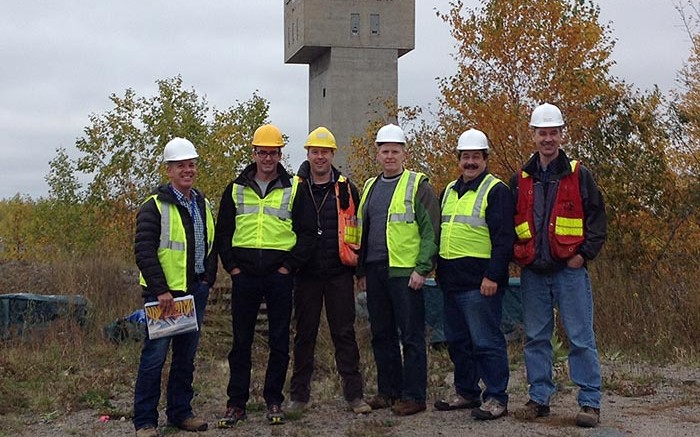
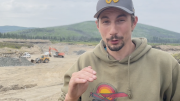
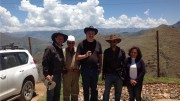
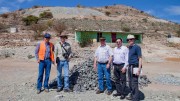
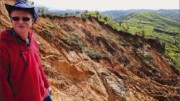
Be the first to comment on "Pure Gold joins Red Lake’s ‘exploration renaissance’"